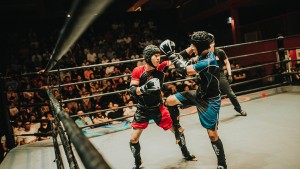Reimagining Sports Training Through Virtual Reality in 2025
Education | June 30, 2025
Virtual reality (VR) is transforming the way athletes train, especially in sports that demand split-second decisions, precise movement, and mental sharpness. From tennis players visualizing match scenarios to quarterbacks rehearsing game reads, VR offers immersive, adaptable environments that bolster physical skills, tactical thinking, and mental resilience. This evolution in training technology aligns perfectly with platforms like OffCourt, which emphasize the off-court edge where champions are made. Ever dreamt of training in of the best tennis academies in North America? Now you can virtually do this!
The Rise of VR in Athlete Performance
Sports-specific VR platforms are now delivering results once reserved for elite performance centers. A recent analytics report found that teams utilizing VR report up to 20 percent improvement in tactical effectiveness and on-field performance (Axios, Promwad). For tennis, systems like Sense Arena allow players to practice shot placement, court positioning, and decision-making at game speed — all from home.
Meanwhile, startups such as VR-Motion (Tennis Esports) provide realistic ball physics and intelligent biomechanical cues, giving players instant insight into optimal swing patterns. These platforms replicate full-court play and tournament pressure with virtual opponents and structured drills.
Immersion Meets Insight: Real-Time Data in VR
One of the most exciting breakthroughs is overlaying live performance metrics within the VR experience. A 2025 study used VR gloves and wearable sensors to display swing speed and power during training sessions. Participants showed better consistency and situational awareness when the data appeared in real time (Sense Arena, arXiv). Immediate feedback allows athletes to adjust technique on the fly, enhancing muscle memory and tactical awareness.
Integrating VR with wearable technology and data overlays is exactly the kind of intelligent off-court training that OffCourt in the untapped power of tennis off-court training. While OffCourt does not provide the hardware directly, its guided routines and performance journal complement this holistic approach: physical drills sync with mental imagery and data-informed reflection.
Sharpening the Mind: VR for Mental Imagery and Tactical Readiness
Physical skill is only half the battle. Mental sharpness, focus, and decision-making under pressure define competitive margins. VR enables athletes to rehearse in high-pressure scenarios without exhaustion or risk. ISPO details how VR recreates real-game conditions, enabling athletes to refine technical skills, tactical analysis, and mental toughness.
Take Australian swimmers, who have used VR to practice relay changeovers with precise timing via 3D simulations — improving split-second coordination without water (The Guardian). In team sports, quarterbacks such as Washington’s Jayden Daniels use VR headsets daily to simulate defensive reads, earning frequent praise from coaches (Axios). These virtual “flight simulators” enable reps at full cognitive intensity — the mental equivalent of physical match prep.
On OffCourt’s blog, The Untapped Power of Off-Court Training highlights why training the 95 percent of the game outside the court is critical. VR is the perfect partner for those routines: it immerses players in realistic match moments, priming reflexes and routines without the wear of physical practice.
Beyond Tennis: VR Across Sports Disciplines
VR is not confined to court sports. It’s expanding into combat sports, track and field, cycling, and rehabilitation. A 2025 review tracked VR’s growing role in karate, fencing, judo, taekwondo, and wrestling. noting faster reaction times and decision-making in experienced users.
Cycling enthusiasts benefit too, with VR cycling offering an enjoyable 3 percent performance boost and more positive mental engagement than indoor trainers (Cycling Weekly).
There’s also growing research into full-body exergaming. One notable study introduced vertical-jump routines in VR, finding that immersive gameplay led to higher engagement and real strength gains (arXiv). These innovations show VR can simultaneously target physical and mental thresholds in ways traditional training cannot.
Tech That’s Taking VR Forward
Advances in hardware are accelerating VR’s potential in sports. Companies like SenseGlove are providing haptic gloves that deliver real-time tactile feedback, adding realism to virtual racket or ball contact (Wikipedia: SenseGlove). Platforms similar to Virti combine AI, wearables, and VR to deliver interactive scenarios with precise feedback (Wikipedia: Virti).
Meanwhile, procedural generation techniques are being used to adapt VR challenges dynamically, keeping athletes engaged and continually challenged. This “experience-driven content” means difficulty adjusts seamlessly to performance, ensuring training remains optimal for both fitness and focus (arXiv).
Phygital Sports: Blending Virtual and Physical Worlds
VR is also giving birth to “phygital” sports: mixed-reality competitions that combine virtual and real-world performance. Some federations are piloting events where athletes compete first in VR, then move to physical play with combined scoring (Wikipedia: Phygital sport). This integration underscores VR’s growing legitimacy as a training and competition platform and highlights the value of blended regimens like those offered by OffCourt Tennis Training.
Why Off-Court Matters More Than Ever
At a time when VR is extending the limits of what on-screen training can offer, OffCourt‘s mission feels prescient. Its system combines mental imagery, physical routines, and performance tracking to build deliberate off-court habits that translate directly onto the court. VR tools pair perfectly with those routines: use OffCourt’s pre-point visualization before you step into a VR simulated high-pressure situation. Log performance notes in the OffCourt journal. Then return to VR or real-court play stronger and more prepared.
OffCourt’s blog post, Untapped Power of Off-Court Training, emphasizes integrating mental and physical elements. VR environments amplify both, reinforcing neural pathways, muscle memory, mental control, and tactical awareness in one immersive session.
Outlook and Challenges
While VR’s applications in sports are broad and growing, challenges remain. Cost and equipment access can limit adoption. Extended VR sessions may cause motion sickness in some users. And there remains a need to ensure technology complements (not replaces) live competitive and technical training.
Still, future trends look promising. Expect VR platforms to integrate biometric signals, adaptive AI, and mixed-reality overlays synchronizing virtual practice with real-world equipment. Smaller devices, better haptics, and richer data capture are already materializing.
A Powerful Partnership
Virtual reality is reshaping sports training across disciplines. For tennis, platforms like Sense Arena and Tennis Esports provide realistic match scenarios with AI opponents. For athletes in general, VR enables tactical rehearsal, consequence-free mental reps, and real-time performance analysis. And with advanced haptics and adaptive content, VR will become even more compelling.
Yet, tools like OffCourt ensure this digital progress doesn’t neglect holistic training. By integrating mental routines, physical drills, and intelligent journaling, OffCourt gives athletes the structure needed to leverage VR and traditional practice together. As VR makes training sessions more immersive and data-rich, OffCourt scaffolds those sessions with planning, reflection, and mental conditioning. This synergy delivers the off-court edge where champions are forged.
Subscribe to our newsletter
We write about the use of Virtual Reality for non-gaming applications.










